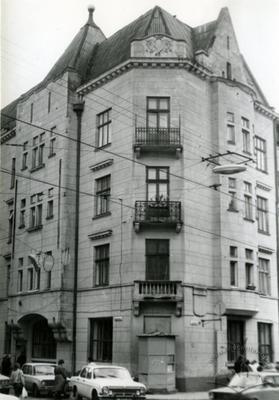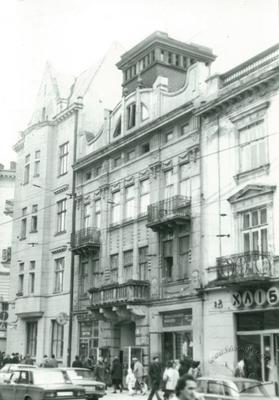Vul. Bohomoltsia, 02 – residential building
The four-storied building at the corner of present Bohomoltsia and Franka streets was built in 1907-1908. It was designed by architect Kazimierz Rzeczycki as a townhouse for doctors Maria and Antoni Sabatowski. The house can be distinguished for its early Modernist style, some motifs of medieval architecture are used in its design. It is an architectural monument of local significance (protection number 2). Today it is a residential building; the Honorary Consulate of Canada in Ukraine and the Lviv utility enterprise № 505 are also located there.
Architecture
The house is located at the corner of Franka and Bohomoltsia streets. This is a residential townhouse built in 1907-1908 under a project designed by architect Kazimierz Rzeczycki. Its style can be defined as early Modernist due to the rationalist approach in its design. It features the use of reinforced concrete, its façades are asymmetrical with minimalist décor (mainly simplified Gothicising elements).
The house has four floors, basements and high hip roof now covered with corrugated metal. The original roof was covered with tiles. The walls are built of brick, the façades are plastered. For window flat arches reinforced concrete was used, so the windows are wide enough.
The building has a complex configuration in plan due to the irregularly-shaped, elongated plot, which was once separated from the larger one (earlier there was a single building in the place of this and neighbouring (Franka street 9) townhouses). The main entrance is located in the northern façade, from where one can get to a small entryway and then to a spacious staircase. According to the original project, two apartments were arranged on each floor: a six-room one and a three-room one. Since the plot is rather narrow, all living rooms’ windows face the street, only auxiliary facilities like halls, corridors, kitchens, and staircases being lit from the courtyard.
The street façades are entirely asymmetrical and do not have typical Historicist order décor. The whole façades’ surface is decorated with a plaster imitation of brickwork made of stone blocks of different sizes. The main accents are a cut corner with balconies and a small attic and three differently designed bay windows. On the façade facing Franka street a segmental bay window has windows of different height. A similar, but three-edged bay window can be seen on the northern façade, with two balconies on the second floor. The third one is rectangular in plan and leans on massive paired cantilevers. All these, along with massive consoles, triangular gables, roof windows in the form simulating loopholes, are stylized elements of medieval architecture. Bay windows are divided by transoms, and some of them also by mullions. A similar approach was typical of residential buildings’ windows in the late Middle Ages. All the windows have no trimmings, and only some of them have linear pediments with exaggerated dentils. The façades are crowned with a cornice.
The building has undergone numerous alterations, most windows have been replaced, as well as the interior staircase design and roofing.
Related Places
Personalities
Andrzej Szelest – owner of a shoes workshop and a storage (1910)
Bronisław Skalkowski – gynecologist, resident of the building (1913)
D. M. Herzgart – denstist, resident of the building (1940)
Ernest Till – owner of the previous building on the same parcel
Z. Link-Aleksiewicz – doctor, resident of the building (1932).
Zygmunt Halber – owner of a chemical enterprise, the Legerax Ltd. (1932).
Kazimierz Rzeczycki – architect who designed the buiding
Karol Hanke – owner of the previous building on the same parcel
Leon Schneider – engineer, resident of the building (1913).
М. А. Gold – resident of the building (1946)
M. Huget Betkowska – tailor who had a workshop in this building (1913).
Marjan Plechowski – lawyer, resident of the building (1932)
Maria z Szypowskich Rozwadowska – owner of the previous building on the same parcel
Maria Sabatowska – medical doctor, Antoni Sabatowski's wife, co-owner of the building
O. A. Schorr – medical doctor, resident of the building (1940)
Aleksander Morawski – lawyer, resident of the building (1913).
Roman Leszczyński – medical doctor, resident of the building (1910).
Róża Seja – owner of the previous building on the same parcel
S. І. Nieroslavskiy – resident of the building (1946)
S. М. Mosin – resident of the building (1946)
Stanisław Stenzel – engineer, resident of the building (1913)
Tadeusz Stobiecki – engineer and chemist, resident of the building (1935–1936)
Sources
- State Archive of Lviv Oblast (DALO) 2/1/122.
- Ksiega Adresowa krolewskiego stolecznego miasta Lwowa (Lemberg, 1913).
- Księga adresowa Małopołski, Wykaz domów na obszarze miasta Lwowa (Lwów. Stanisławów. Tarnopól, 1935/1936), 2.
- Lewicki Jakub, Między tradycją a nowoczesnością: Architektura Lwowa lat 1893–1918 (Warszawa: Towarzystwo Opieki nad Zabytkami, Wydawnictwo Neriton, 2005), 258-260.
- Mączyński Franciszek, Najnowszy Lwów, Architekt, "Miesięcznik poświęcony architekturze, budownictwu i przemysłowi artystycznemu", 1908, Zeszyt 9, 91-97.
- Skorowidz krolewskiego stolecznego miasta Lwowa (Lemberg, 1872).
- Skorowidz krolewskiego stolecznego miasta Lwowa (Lemberg, 1889).
- Skorowidz krolewskiego stolecznego miasta Lwowa (Lemberg, 1910).
- Spis abonentow sieci telefonicznej..., 1937.
Media Archive Materials
Related Pictures













